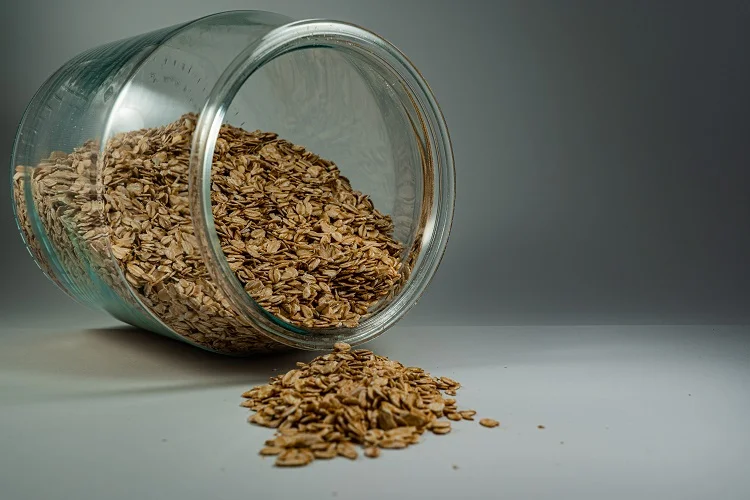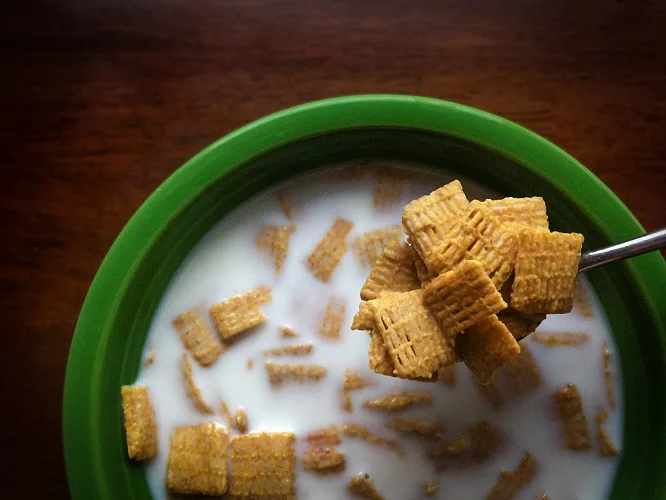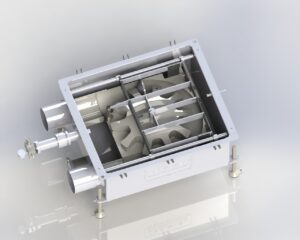Have you ever wondered – what is the origin story of the breakfast cereal? Very few people in the Western world don’t know what breakfast cereal is. However, for those not familiar with it, breakfast cereal is a type of packaged food product that’s typically made out of cereal grains and is usually eaten cold as a ready-to-eat meal. Most often, breakfast cereal is mixed with a liquid, usually cow’s milk or water, though it can also be paired with yogurt, plant-based milk, chocolate, and fruit.
How It’s Made
Many breakfast cereals today are made through a food processing method known as extrusion. This is where a set of ingredients is forced through an opening in a perforated plate or die with a certain design and is cut to a specific size. Some companies will promote their products for the health benefits associated with eating oat-based, high-fiber foods. In the United States, cereals are also often fortified with specific vitamins.
However, a significant segment of the market is made with high sugar content and often marketed towards children by featuring a cartoon mascot or containing a toy or prize. Warm cereals like porridge or grits are somewhat of an exception to the rule since they need to be prepared and are eaten hot. These also have the longest history, with various hot cereal recipes being used at least as early as Roman times.
The State of the Industry
Today, breakfast cereal consumption is at an all-time high around the world. Let’s look at some statistics:
- In 2020, the global breakfast cereal industry was estimated at around $62.7 billion.
- The United States made up a considerable share of the revenues, at around $20.1 billion.
- In relation to the global population, the revenues per person were at $8.43, whereas in the United States, that figure was close to $61.
However, the global market is expanding quickly, at a compound annual growth rate (CAGR) of 4.1%, as compared to the United States at 1.7%. This lower but extensive growth rate makes sense since the US is the birthplace of breakfast cereal.

What Is the Origin Story of the Breakfast Cereal? Let’s Start at the Beginning
Breakfast cereal had its start with the vegetarian movement of the latter part of the 19th century. The main breakfast in the Western world at the time was made up of eggs, bacon, sausage, and beef. Dr. James Caleb Jackson later went on to invent the first cold cereal called Granula in 1863, which was named after the granules it was made of. Dr. Jackson had a rather fascinating life that eventually led him to the invention of cereal.
Early Life and Influence of Dr. James Caleb Jackson
Born in 1811 in upstate New York, he worked as a farmer and actively opposed slavery during the 1820s and ’30s. He lectured about abolition, was the secretary for a local anti-slavery group, and managed The Albany Patriot, an anti-slavery newspaper. By the mid-1840s, illness prevented him from overseeing the newspaper. He then explored hydropathy, an alternative therapy using water for pain relief and healing.
Embracing Hydropathy and Clean Eating
James Caleb Jackson also became an early proponent of so-called “clean eating,” which involved eating fruits, vegetables, and whole grains while refraining from meat and processed foods, such as white flour, caffeine, alcohol, and tobacco. Feeling inspired by his newfound interest in healthy living, he decided to become a doctor. In 1850, he earned his medical degree from the Central Medical College in Syracuse, New York. After several years of working at a hydropathic institute, Dr. Jackson moved to Dansville, New York, and took over the management of a similar spa there. After he took over, the Dansville Water Cure facility changed its name to Our Home On The Hillside, but it was also commonly known as the Jackson Health Resort or the Jackson Sanatorium.
The Jackson Health Resort and Its Influence
The resort quickly became one of the most famous spas in the country, drawing in thousands of patients every year. Among the most famous were Ellen White, the founder of the Seventh-day Adventist Church, and Clara Barton, the founder of the American Red Cross. In fact, nurse Clara Barton liked Jackson’s facility so much that she eventually chose it to be the location for the Red Cross’ first chapter.
Aside from hydropathy, Dr. Jackson also promoted the eating of unprocessed foods. Realizing the critical role that nutrition has on one’s health and well-being, Dr. Jackson created a dry, whole-grain breakfast cereal by baking graham flour and bran and crumbling it. Even though this granula required around 20 minutes of soaking in milk or water because of its hardness, it was still a more convenient breakfast recipe than hot cereals that required cooking.

Introduction of the Kellogg Brothers
In 1878, Dr. John Harvey Kellogg visited the Jackson Sanatorium to learn more about Dr. Jackson’s health and wellness practices, which he heard about from the church leader Ellen White. At that time, Kellogg was running his own facility, known as the Battle Creek Sanitarium in Battle Creek, Michigan, and several years after this visit, Kellogg invented his own version of Jackson’s cereal in 1877. His version was made of ground oats, cornmeal, and wheat, specifically aimed at those suffering from bowel issues. He also called it Granula, but Jackson sued Kellogg for the name, and he eventually changed the name of the cereal from Granula to Granola.
Kellogg’s Innovation and Rise
However, the most famous invention attributed to John Kellogg was created by chance. He accidentally left a batch of boiled wheat to soak overnight, resulting in what we know as wheat flakes. His brother, William Kellogg, later invented cornflakes using a similar method. He bought his brother’s share in the business and went on to found the Kellogg Company in 1906. In just three years, Kellogg’s sold its one-millionth case of the quintessentially American breakfast food.
The Entry of Charles William Post
One of Kellogg’s patients, Charles William Post, also went on to become one of the first pioneers in the American breakfast cereal industry in the late 19th century. One of Post’s first produced and marketed products was a cereal beverage he named Postum. With it, he created the Postum Cereal Co. Ltd., later to be called the General Foods Corporation. Other noteworthy breakfast foods created by Post included Grape Nuts (1897) and Post Toasties (1904), which were originally called Elijah’s Manna.
You can hear some other facts about the origins of this easy breakfast meal in the following video.
Fast-Forwarding Through the Decades
Starting with World War II, big breakfast cereal companies increasingly started to advertise their products to children. By this time, General Mills also entered the market with Wheaties in the mid-1920s and Kix in the ’30s. CheeriOats was quickly renamed to Cheerios, which would become America’s best-selling cereal, surpassing $1 billion in 2015. Honey Nut Cheerios was also introduced by General Mills in 1979, becoming the brand’s most popular version.
Post-War Changes – Sugar and Cartoon Mascots
After World War II, cereal consumption saw a significant increase, particularly with the advent of the baby boom and the introduction of sugar into those breakfast recipes. In a relatively short amount of time, the once-healthy breakfast became increasingly different from its predecessors. For example, Kellogg’s Sugar Smacks, created in 1953, had a 56% sugar content. It was also at this time when cartoon mascots, such as Frosted Flakes’ Tony the Tiger and the Trix Rabbit, were introduced into cereal marketing.
Space Age Cereals of the 1960s
During the 1960s space age, the Quaker Oats Company introduced Quisp, a pink-skinned alien featured on the cereal box. Though Quisp has been discontinued, it has also been brought back periodically. However, Cap’n Crunch, another Quaker Oats Company product from this time period, remains strong to this day. Cap’n Crunch is a sweetened and extruded oat and corn dough.
1970s – Flavor Innovations and Federal Oversight
In the 1970s, fruit-flavored monster cereals became a favorite. General Mills Count Chocula, Boo Berry, and Franken Berry are still enjoyed across the country. It was also around this time when granola started making a comeback, and the Federal Trade Commission (FTC) started taking a closer look at how cereal companies were marketing their products to children.
1980s – Era of Co-branding, and 1990s, a Return to Health-Conscious Cereals
The 1980s were defined by co-branding with Cabbage Patch Kids, Donkey Kong, and Smurf-Berry Crunch all promoting different cereals. The concept of healthy breakfast cereals was brought back in the 1990s, with Puffins, which is essentialy a molasses-sweetened corn cereal, being promoted as organic food. And with that, more and more parents began searching out more healthy alternatives.
2000s – The Organic and Transparency Movement
The same trend dominated the 2000s, as cereal companies looked to brand their products as natural and organic foods. It was also at this time that consumers started demanding more label transparency and the discontinuation of GMOs and other artificial ingredients. In 2019, Nature’s Path Foods voluntarily recalled over 400,000 boxes of its EnviroKidz line, including Jungle Munch, Gorilla Munch, and Choco Chimps, for containing gluten, even though these products were marketed as gluten-free.
Breakfast Cereals in 2020 and Beyond
Going forward into the next decade, breakfast cereal manufacturers can expect the same level of interest regarding products with healthier, less-processed ingredients. The nutritional content will need to remain a top priority for new product development, particularly among developed markets in North America and Europe. There are niche breakfast cereal producers that cater to specific health trends, such as organic – non-GMO, gluten-free, keto-friendly, and more. To add additional value to their health branding, many cereal brands also incorporate probiotics and certain grains, seeds, or nuts that are considered to be “superfoods.”
Around the World
In emerging markets around the world, in areas such as Asia/Pacific and Africa/Mideast, breakfast cereals are becoming more commonplace and are expanding faster than in Europe or America. Nevertheless, American producers are looking at various creative tactics to boost consumption in the United States and keep customers engaged with their products. One common strategy is launching new cereals with more indulgent and eye-catching flavors. Some of them even play on nostalgia. General Mills Cinnamon Toast Crunch Churros and Kellogg’s Caticorn are a few examples. Another strategy is to deposit cereal as not just a breakfast but also as an “anytime” food that can be a snack or dessert.

Upgrade Your Production With the Right Conveyor Belt System
Breakfast cereal manufacturers should also pay close attention to the belt conveyor system used during processing. Cablevey’s tubular drag cable and disc systems excel at moving extruded cereal materials, such as grain, nuts, granolas, and more, from one processing station to another. Other bulk material handling equipment systems, such as chain, aero-mechanical, pneumatic conveyor systems, vacuum conveyors, or bucket elevators, are met with critical challenges when conveying delicate materials such as grains. However, tubular cable and disc conveyor systems do not toss, crush, or beat the cereal blend made of nuts and other components, regardless of how fragile the mix is.
As such, this tubular industrial conveyor belt for food will maintain the recipe precisely as the food scientist formulated it. In addition, tubular cable and disk systems do eliminate the risk of spillage and contamination, ensuring both the quality and integrity of the product throughout the entirety of the production process. Many top cereal companies globally use these types of conveying systems in their production process. If you want to learn more about Cablevey’s tubular drag cable and disc systems and how we can customize your operations with a custom conveyor belt for the warehouse or automate your system, feel free to contact us today!






